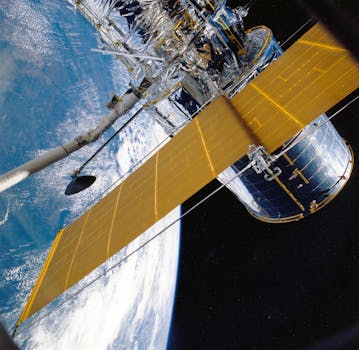MEO Satellites: Revolutionizing Global Connectivity with Medium Earth Orbit Technology

MEO Satellites: Revolutionizing Global Connectivity with Medium Earth Orbit Technology
MEO satellites, or Medium Earth Orbit satellites, are a type of satellite that operates at an altitude of around 2,000 to 36,000 kilometers above the Earth’s surface. This range allows them to provide a unique combination of low latency and wide coverage, making them ideal for a variety of applications, including telecommunications, navigation, and Earth observation.
How MEO Satellites Work
MEO satellites work by transmitting and receiving data to and from Earth stations, which are located on the ground. They use a combination of radio frequencies and microwave signals to communicate with these stations, and can provide a range of services, including broadband internet, voice communications, and data transmission. One of the key advantages of MEO satellites is their low latency, which is the delay between the time data is sent and the time it is received. This is because they are closer to the Earth’s surface than other types of satellites, such as Geostationary satellites, which operate at an altitude of around 36,000 kilometers.
Applications of MEO Satellites
MEO satellites have a range of applications, including telecommunications, navigation, and Earth observation. In the telecommunications sector, they are used to provide broadband internet and voice communications to remote and underserved areas, where traditional fiber optic cables are not available. They are also used to provide backup services in case of natural disasters or other emergencies. In the navigation sector, MEO satellites are used to provide location information and timing signals, which are essential for a range of applications, including aviation, maritime, and land transportation. They are also used to provide Earth observation data, which is used to monitor the environment, track weather patterns, and predict natural disasters.
Benefits of MEO Satellites
The benefits of MEO satellites are numerous. They provide a range of advantages over traditional telecommunications technologies, including lower latency, wider coverage, and greater reliability. They are also more cost-effective than other types of satellites, such as Geostationary satellites, which require more power and are more expensive to launch and maintain. Additionally, MEO satellites are more flexible and can be easily reconfigured to provide different services and applications.
Challenges and Limitations of MEO Satellites
Despite the many benefits of MEO satellites, there are also some challenges and limitations to their use. One of the main challenges is the high cost of launching and maintaining them, which can be prohibitively expensive for some organizations. Additionally, MEO satellites are subject to interference from other satellites and terrestrial systems, which can affect their performance and reliability. Furthermore, the signals transmitted by MEO satellites can be affected by atmospheric conditions, such as rain and solar activity, which can impact their quality and availability.
